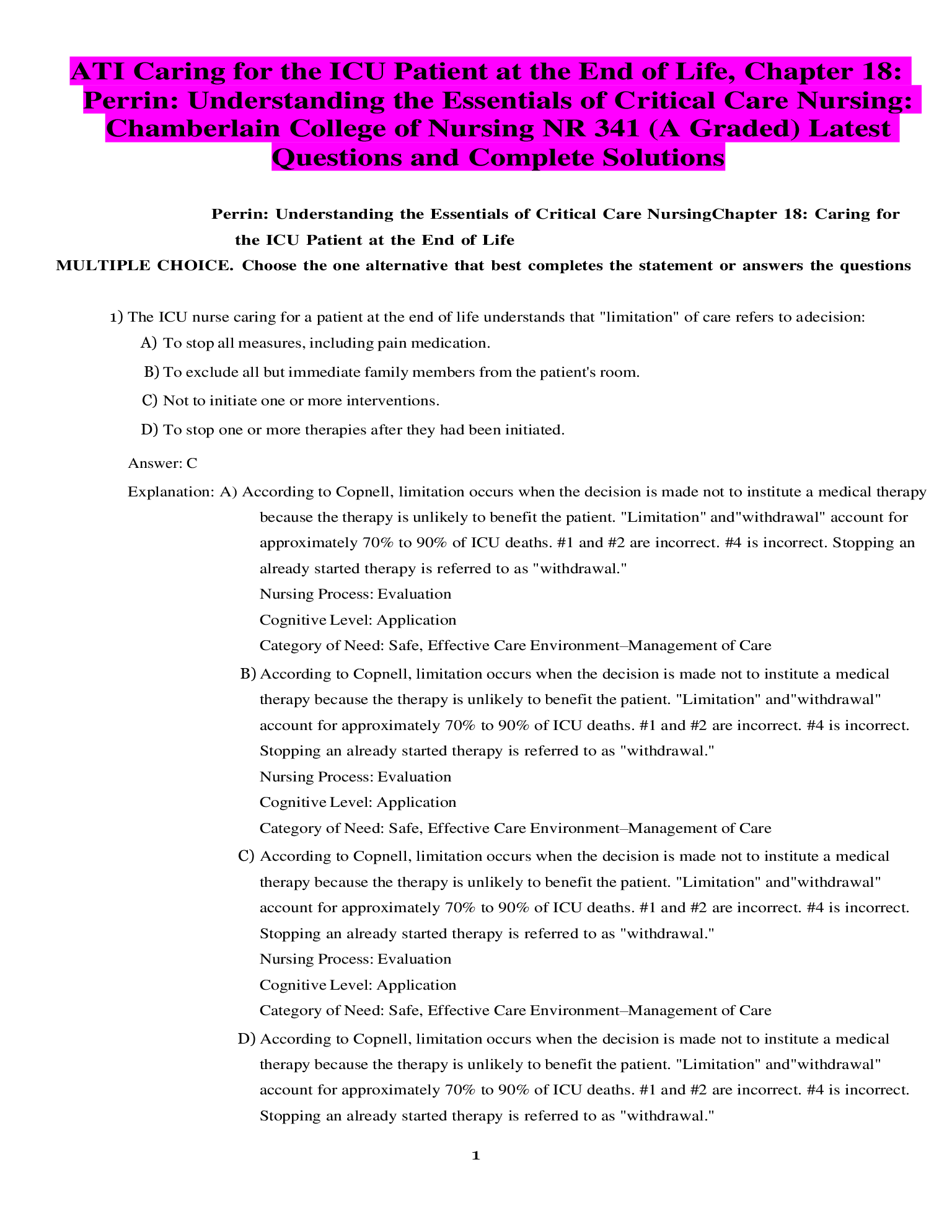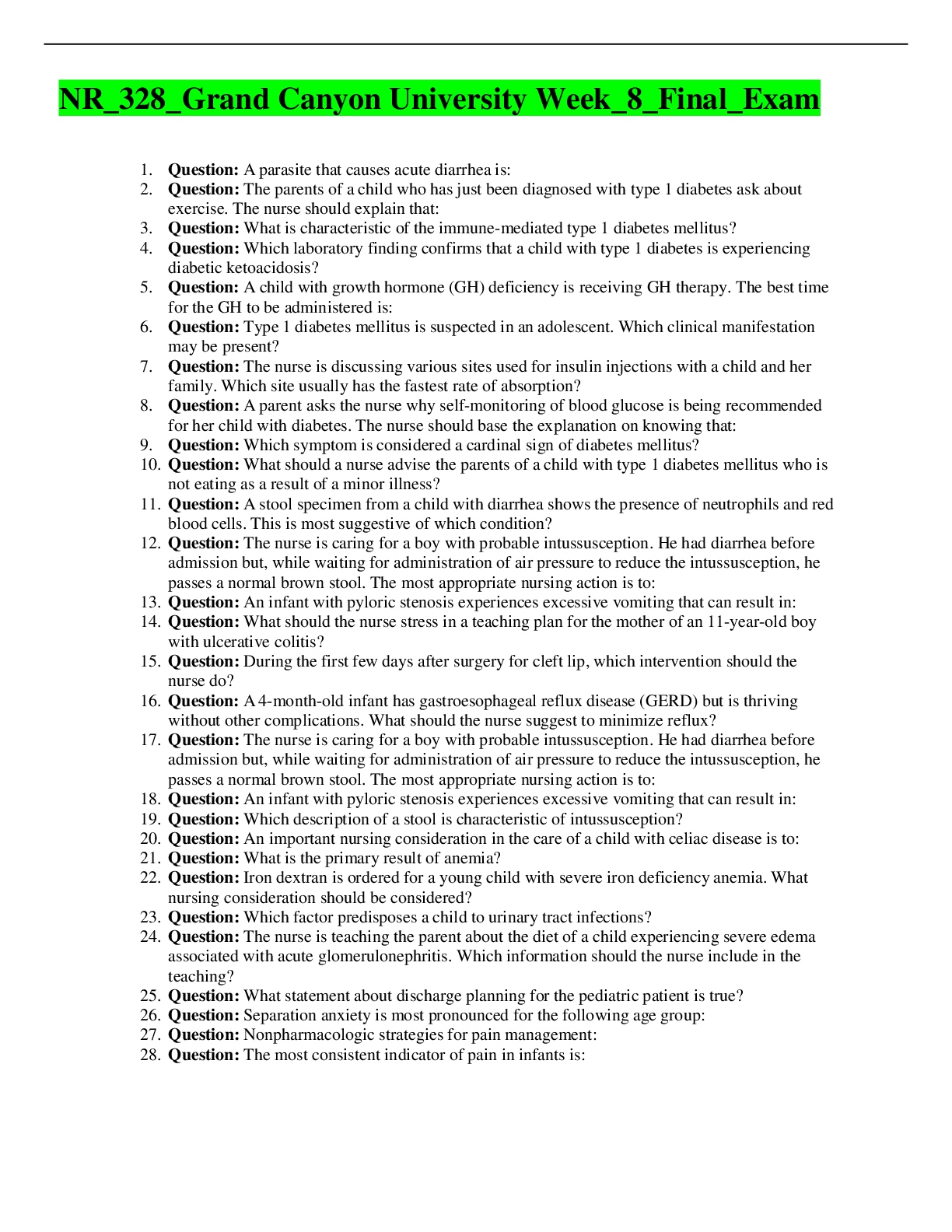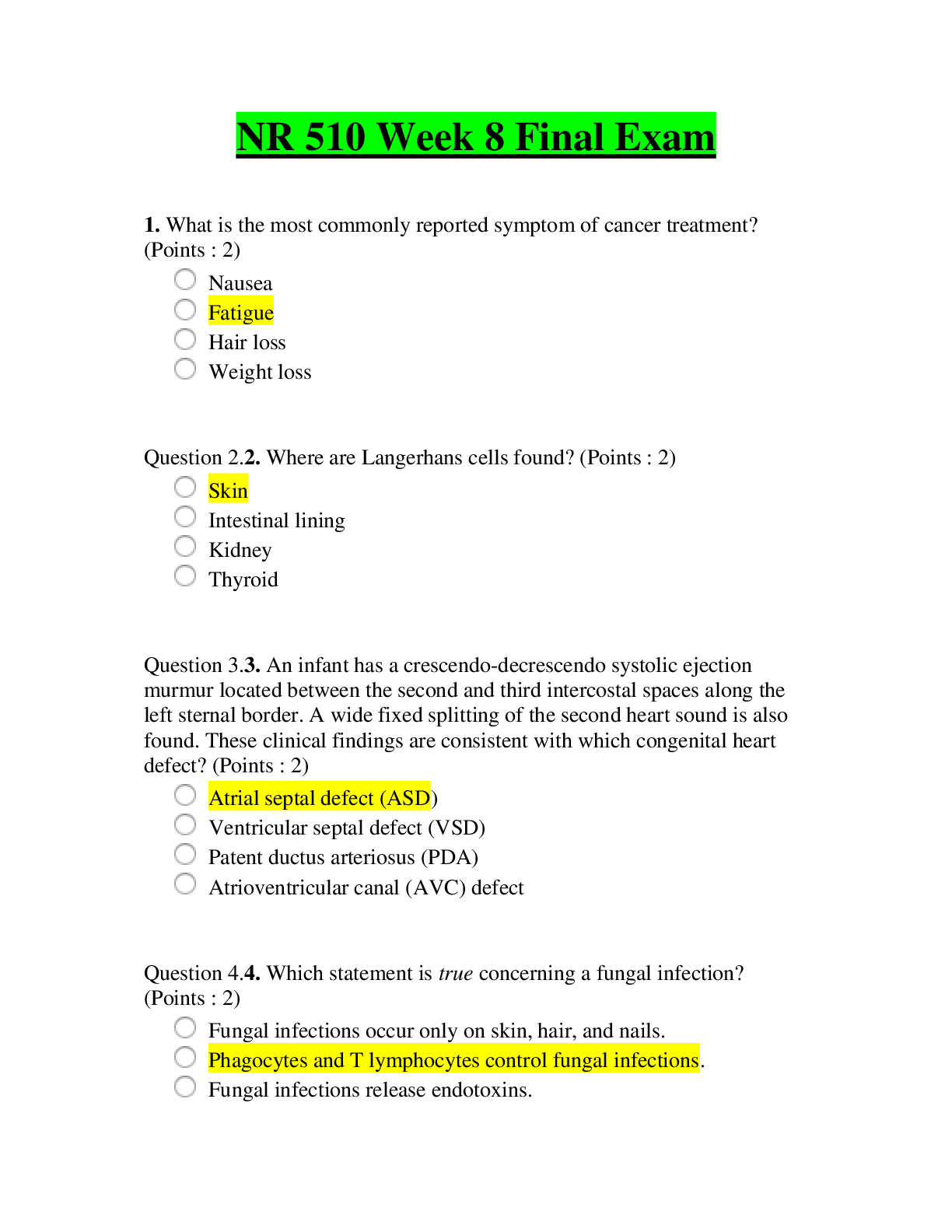Health Care > QUESTIONS & ANSWERS > ATI Caring for the ICU Patient at the End of Life, Chapter 18: Perrin: Understanding the Essentials (All)
ATI Caring for the ICU Patient at the End of Life, Chapter 18: Perrin: Understanding the Essentials of Critical Care Nursing: Chamberlain College of Nursing NR 341 (A Graded) Latest Questions and Complete Solutions
Document Content and Description Below
ATI Caring for the ICU Patient at the End of Life, Chapter 18: Perrin: Understanding the Essentials of Critical Care Nursing: Chamberlain College of Nursing NR 341 (A Graded) Latest Questions and Comp... lete Solutions Perrin: Understanding the Essentials of Critical Care Nursing Chapter 18: Caring for the ICU Patient at the End of Life MULTIPLE CHOICE. Choose the one alternative that best completes the statement or answers the questions 1) The ICU nurse caring for a patient at the end of life understands that "limitation" of care refers to a decision: A) To stop all measures, including pain medication. B) To exclude all but immediate family members from the patient's room. C) Not to initiate one or more interventions. D) To stop one or more therapies after they had been initiated. Answer: C Explanation: A) According to Copnell, limitation occurs when the decision is made not to institute a medical therapy because the therapy is unlikely to benefit the patient. "Limitation" and "withdrawal" account for approximately 70% to 90% of ICU deaths. #1 and #2 are incorrect. #4 is incorrect. Stopping an already started therapy is referred to as "withdrawal." Nursing Process: Evaluation Cognitive Level: Application Category of Need: Safe, Effective Care Environment–Management of Care B) According to Copnell, limitation occurs when the decision is made not to institute a medical therapy because the therapy is unlikely to benefit the patient. "Limitation" and "withdrawal" account for approximately 70% to 90% of ICU deaths. #1 and #2 are incorrect. #4 is incorrect. Stopping an already started therapy is referred to as "withdrawal." Nursing Process: Evaluation Cognitive Level: Application Category of Need: Safe, Effective Care Environment–Management of Care C) According to Copnell, limitation occurs when the decision is made not to institute a medical therapy because the therapy is unlikely to benefit the patient. "Limitation" and "withdrawal" account for approximately 70% to 90% of ICU deaths. #1 and #2 are incorrect. #4 is incorrect. Stopping an already started therapy is referred to as "withdrawal." Nursing Process: Evaluation Cognitive Level: Application Category of Need: Safe, Effective Care Environment–Management of Care D) According to Copnell, limitation occurs when the decision is made not to institute a medical therapy because the therapy is unlikely to benefit the patient. "Limitation" and "withdrawal" account for approximately 70% to 90% of ICU deaths. #1 and #2 are incorrect. #4 is incorrect. Stopping an already started therapy is referred to as "withdrawal." Nursing Process: Evaluation Cognitive Level: Application Category of Need: Safe, Effective Care Environment–Management of Care 2) According to Copnell (2005), the decision not to start needed dialysis treatment on a patient in ICU would fall under which category of ICU deaths? A) Failed CPR B) Withdrawal C) Brain death D) Limitation Answer: D Explanation: A) Limitation refers to the decision to not initiate one or more interventions, such as ventilation, intubation, dialysis, enteral feedings, or vasopressors. #1 is incorrect. When the death occurs despite all efforts by clinicians, it is called failed CPR. #2 is incorrect. Withdrawal is the category in which a therapy has been stopped after a decision was made that the therapy was not beneficial to the patient. #3 is incorrect. Brain death occurs when validation has shown that the brainstem lacks functioning. Nursing Process: Evaluation Cognitive Level: Application Category of Need: Safe, Effective Care Environment–Management of Care B) Limitation refers to the decision to not initiate one or more interventions, such as ventilation, intubation, dialysis, enteral feedings, or vasopressors. #1 is incorrect. When the death occurs despite all efforts by clinicians, it is called failed CPR. #2 is incorrect. Withdrawal is the category in which a therapy has been stopped after a decision was made that the therapy was not beneficial to the patient. #3 is incorrect. Brain death occurs when validation has shown that the brainstem lacks functioning. Nursing Process: Evaluation Cognitive Level: Application Category of Need: Safe, Effective Care Environment–Management of Care C) Limitation refers to the decision to not initiate one or more interventions, such as ventilation, intubation, dialysis, enteral feedings, or vasopressors. #1 is incorrect. When the death occurs despite all efforts by clinicians, it is called failed CPR. #2 is incorrect. Withdrawal is the category in which a therapy has been stopped after a decision was made that the therapy was not beneficial to the patient. #3 is incorrect. Brain death occurs when validation has shown that the brainstem lacks functioning. Nursing Process: Evaluation Cognitive Level: Application Category of Need: Safe, Effective Care Environment–Management of Care D) Limitation refers to the decision to not initiate one or more interventions, such as ventilation, intubation, dialysis, enteral feedings, or vasopressors. #1 is incorrect. When the death occurs despite all efforts by clinicians, it is called failed CPR. #2 is incorrect. Withdrawal is the category in which a therapy has been stopped after a decision was made that the therapy was not beneficial to the patient. #3 is incorrect. Brain death occurs when validation has shown that the brainstem lacks functioning. Nursing Process: Evaluation Cognitive Level: Application Category of Need: Safe, Effective Care Environment–Management of Care [Show More]
Last updated: 2 years ago
Preview 1 out of 53 pages

Buy this document to get the full access instantly
Instant Download Access after purchase
Buy NowInstant download
We Accept:

Reviews( 0 )
$17.50
Can't find what you want? Try our AI powered Search
Document information
Connected school, study & course
About the document
Uploaded On
May 24, 2021
Number of pages
53
Written in
Additional information
This document has been written for:
Uploaded
May 24, 2021
Downloads
0
Views
91


 Questions and Answers (latest Update), All Correct, Download to Score A.png)






, (A Grade), Questions and Answers, All Correct Study Guide, Download to Score A.png)
, Questions and Answers, All Correct Study Guide, Download to Score A.png)
, Latest Questions and Answers with Explanations, All Correct Study Guide, Download to Score A.png)


 Questions and Answers (latest Update), 100% Correct, Download to Score A.png)
.png)

 Questions and Answers (latest Update)Download to Score A.png)
 Correct Study Guide, Download to Score A.png)
 FINAL TEST 1, Latest Questions and Answers with Explanations for Revision, All Correct Latest Review, (Latest 2021) Correct Study Guide, Download to Score A.png)

 Correct Study Guide, Download to Score A.png)
 Correct Study Guide, Download to Score A.png)

